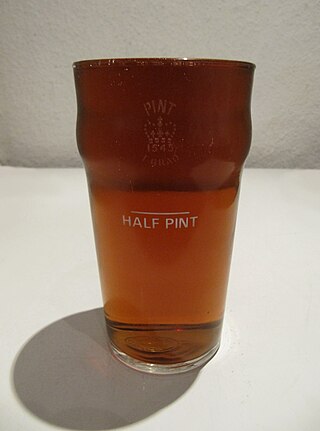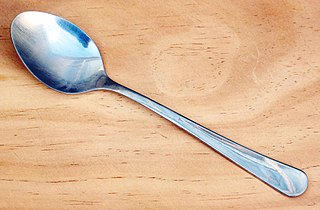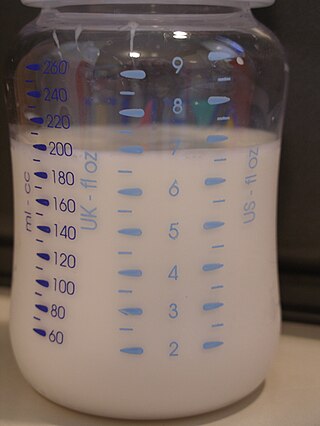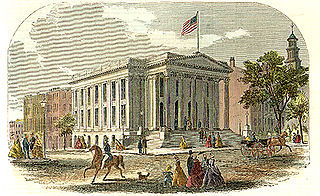Density is a substance's mass per unit of volume. The symbol most often used for density is ρ, although the Latin letter D can also be used. Mathematically, density is defined as mass divided by volume:

The gallon is a unit of volume in British imperial units and United States customary units. Three different versions are in current use:

United States customary units form a system of measurement units commonly used in the United States and most U.S. territories, since being standardized and adopted in 1832. The United States customary system developed from English units that were in use in the British Empire before the U.S. became an independent country. The United Kingdom's system of measures was overhauled in 1824 to create the imperial system, which was officially adopted in 1826, changing the definitions of some of its units. Consequently, while many U.S. units are essentially similar to their imperial counterparts, there are significant differences between the systems.

In recipes, quantities of ingredients may be specified by mass, by volume, or by count.

Engine displacement is the measure of the cylinder volume swept by all of the pistons of a piston engine, excluding the combustion chambers. It is commonly used as an expression of an engine's size, and by extension as an indicator of the power an engine might be capable of producing and the amount of fuel it should be expected to consume. For this reason displacement is one of the measures often used in advertising, as well as regulating, motor vehicles.

The pint is a unit of volume or capacity in both the imperial and United States customary measurement systems. In both of those systems it is traditionally one eighth of a gallon. The British imperial pint is about 20% larger than the American pint because the two systems are defined differently. Almost all other countries have standardized on the metric system, so although some of them still also have traditional units called pints, the volume varies by regional custom.
The cubic foot is an imperial and US customary (non-metric) unit of volume, used in the United States and the United Kingdom. It is defined as the volume of a cube with sides of one foot in length. Its volume is 28.3168 L.
The quart is an English unit of volume equal to a quarter of a gallon. Three kinds of quarts are currently used: the liquid quart and dry quart of the US customary system and the imperial quart of the British imperial system. All are roughly equal to one liter. It is divided into two pints or four cups. Historically, the exact size of the quart has varied with the different values of gallons over time and in reference to different commodities.

A fluid ounce is a unit of volume typically used for measuring liquids. The British Imperial, the United States customary, and the United States food labeling fluid ounce are the only three that are still in common use, although various definitions have been used throughout history.

A bushel is an imperial and US customary unit of volume based upon an earlier measure of dry capacity. The old bushel is equal to 2 kennings (obsolete), 4 pecks, or 8 dry gallons, and was used mostly for agricultural products, such as wheat. In modern usage, the volume is nominal, with bushels denoting a mass defined differently for each commodity.

A barrel is one of several units of volume applied in various contexts; there are dry barrels, fluid barrels, oil barrels, and so forth. For historical reasons the volumes of some barrel units are roughly double the volumes of others; volumes in common use range approximately from 100 to 200 litres. In many connections the term drum is used almost interchangeably with barrel.

A dessert spoon is a spoon designed specifically for eating dessert and sometimes used for soup or cereals. Similar in size to a soup spoon but with an oval rather than round bowl, it typically has a capacity around twice that of a teaspoon.
English units were the units of measurement used in England up to 1826, which evolved as a combination of the Anglo-Saxon and Roman systems of units. Various standards have applied to English units at different times, in different places, and for different applications.

Both the British imperial measurement system and United States customary systems of measurement derive from earlier English unit systems used prior to 1824 that were the result of a combination of the local Anglo-Saxon units inherited from Germanic tribes and Roman units.
Dry measures are units of volume to measure bulk commodities that are not fluids and that were typically shipped and sold in standardized containers such as barrels. They have largely been replaced by the units used for measuring volumes in the metric system and liquid volumes in the imperial system but are still used for some commodities in the US customary system. They were or are typically used in agriculture, agronomy, and commodity markets to measure grain, dried beans, dried and fresh produce, and some seafood. They were formerly used for many other foods, such as salt pork and salted fish, and for industrial commodities such as coal, cement, and lime.
Dimensional weight, also known as volumetric weight, is a pricing technique for commercial freight transport, which uses an estimated weight that is calculated from the length, width and height of a package.
The dry gallon, also known as the corn gallon or grain gallon, is a historic British dry measure of volume that was used to measure grain and other dry commodities and whose earliest recorded official definition, in 1303, was the volume of 8 pounds (3.6 kg) of wheat. It is not used in the US customary system – though it implicitly exists since the US dry measures of bushel, peck, quart, and pint are still used – and is not included in the National Institute of Standards and Technology handbook that many US states recognize as the authority on measurement law.

The imperial and US customary measurement systems are both derived from an earlier English system of measurement which in turn can be traced back to Ancient Roman units of measurement, and Carolingian and Saxon units of measure.
The quarter was used as the name of several distinct English units based on ¼ sizes of some base unit.
The Exchequer Standards may refer to the set of official English standards for weights and measures created by Queen Elizabeth I, and in effect from 1588 to 1825, when the Imperial units system took effect, or to the whole range of English unit standards maintained by the Court of the Exchequer from the 1200s, or to the physical reference standards physically kept at the Exchequer and used as the legal reference until the such responsibility was transferred in the 1860s, after the Imperial system had been established.











